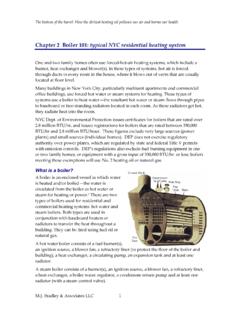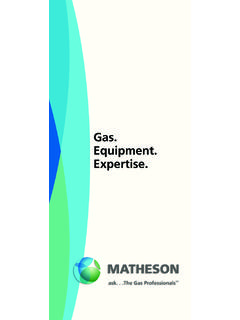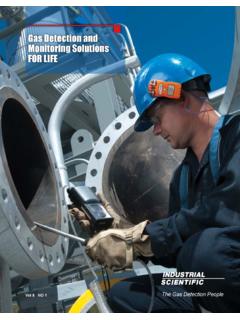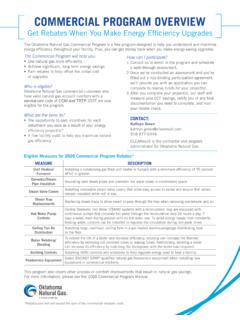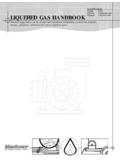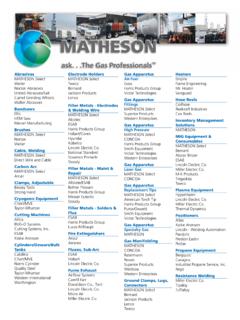Transcription of Economic Analysis of Methane Emission Reduction ...
1 Economic Analysis of Methane Emission Reduction Opportunities in the Onshore Oil and natural Gas Industries March 2014 Prepared for Environmental Defense Fund 257 Park Avenue South New York, NY 10010. Prepared by ICF International 9300 Lee Highway Fairfax, VA 22031 blank page Economic Analysis of Methane Emission Reduction Opportunities in the Onshore Oil and natural Gas Industries Contents 1. Executive Summary .. 1 1 2. Introduction .. 2 1 Goals and Approach of the Study .. 2 1 Overview of Gas Sector Methane Emissions .. 2 2 Climate Change Forcing Effects of Methane .. 2 5 Cost Effectiveness of Emission Reductions .. 2 6 3. Approach and Methodology .. 3 1 Overview of Methodology .. 3 1 Development of the 2011 Emissions Baseline .. 3 2 Projection to 2018.
2 3 4 Identification of Targeted Emission Sources .. 3 6 Selected Mitigation Technologies .. 3 9 Source Categories Not Addressed .. 3 23 4. Analytical Results .. 4 1 Development of Emission Control Cost Curves .. 4 1 Emission Reduction Cost Curves .. 4 2 Co Benefits .. 4 11 5. Case Studies .. 5 1 Wet Seal Compressor Degassing for Centrifugal Compressors .. 5 1 Dry Seal Replacement/Retrofit .. 5 2 Wet Seal Degassing Capture Systems .. 5 2 Economic Analysis of Installing Wet Seal Degassing Capture Systems .. 5 3 Liquids Unloading .. 5 6 Background .. 5 6 Plunger Lifts .. 5 7 Additional Options for Removing or Remediating Liquids Problems .. 5 9 Liquids Issues in Horizontal Wells .. 5 12 6. Conclusions .. 6 1 Appendix A. Additional Sensitivities.
3 A 1 Appendix B. Development of the 2011 Emissions Baseline .. B 1 Appendix C. Emission Projection to 2018 .. C 1 Appendix D. Methane Mitigation Technologies .. D 1 Figures Figure 1 1 Marginal Abatement Cost Curve for Methane Reductions by Source .. 1 2 Figure 2 1 natural Gas Industry Processes and Example Methane Emission Sources .. 2 3 Figure 3 1 Emission Projection to 2018 (Including Offshore) .. 3 5 Figure 3 2 Distribution of Emissions in 2018 .. 3 5 ICF International iii March 2014 Economic Analysis of Methane Emission Reduction Opportunities in the Onshore Oil and natural Gas Industries Figure 3 3 EIA Oil and Gas Regions .. 3 6 Figure 3 4 2018 Projected Onshore Emissions .. 3 8 Figure 3 5 Reciprocating Compressor Rod Packing .. 3 13 Figure 3 6 Wet Seal Compressor Schematic.
4 3 15 Figure 3 7 Plunger Lift Schematic .. 3 17 Figure 4 1 Example MAC Curve .. 4 2 Figure 4 2 National Aggregate MAC Curve for Baseline Technology Assumptions .. 4 3 Figure 4 3 Distribution of Emission Reduction Potential .. 4 5 Figure 4 4 Emission Reduction by Industry Segment .. 4 6 Figure 4 5 Emission Reductions for the Gas Production Segment .. 4 7 Figure 4 6 Emission Reductions for the Oil Production Segment .. 4 8 Figure 4 7 Emission Reductions for the Gathering and Boosting Segment .. 4 9 Figure 4 8 Emissions Reductions for the Gas Transmission Segment .. 4 9 Figure 4 9 National Aggregate MAC Curve with Baseline Technology Assumption and Economy Wide Value Recognition .. 4 10 Figure 4 10 National Aggregate MAC Curve by Region .. 4 11 Figure 4 11 Co Benefit Reductions of VOCs and HAPs.
5 4 12 Figure 4 12 VOC Reduction Co Benefits .. 4 12 Figure 4 13 Hazardous Air Pollutant Co Benefits .. 4 13 Figure 5 1 Dry Seals on a Centrifugal Compressor .. 5 2 Figure 5 2 Wet seal degassing recovery system for centrifugal compressors (Source EPA) .. 5 3 Figure 5 3 Plunger Lift Schematic .. 5 7 Figure 5 4 Installation of Velocity Tubing Serving to Reduction the Cross Section Area of the Production Tubing .. 5 11 Figure 5 5 Different Types of Horizontal Wells .. 5 13 Tables Table 3 1 Summary of 2011 Methane Emissions Baseline .. 3 3 Table 3 2 Highest Emitting Onshore Methane Source Categories in 2018 .. 3 7 Table 3 3 LDAR Hourly Cost Calculation .. 3 10 Table 3 4 Cost Calculation Quarterly LDAR .. 3 12 Table 3 5 Assumptions for Rod Packing Replacement.
6 3 14 Table 3 6 Summary of Mitigation Measures Applied .. 3 21 Table 3 7 Summary of Mitigation Measure Characteristics .. 3 22 Table 4 1 Annualized Cost and Reduction and Initial Capital Cost .. 4 4 Table 4 2 Initial Capital Cost by Industry Segment .. 4 7 Table 5 1 Degassing Recovery System Estimated Installation and Equipment Costs .. 5 4 Table 5 2 Wet Seal Degassing Recovery System Costs and Savings for One Compressor .. 5 6 Table 5 3 Wet Seal Degassing Recovery System Costs and Savings for Four Compressors at a Station .. 5 6 Table 5 4 Reported Capital and Operating Cost Ranges for Installing Plunger Lift Systems .. 5 9 ICF International iv March 2014 Economic Analysis of Methane Emission Reduction Opportunities in the Onshore Oil and natural Gas Industries Acknowledgement ICF received and considered data and commentary from numerous stakeholder organizations, including oil and gas producers, pipelines, equipment vendors, service providers, and a trade organization.
7 No information in this report should be attributed to any single organization, as all data is aggregated from multiple sources and often uses average values. Furthermore, acknowledgement of industry participation does not imply their agreement with the study conclusions, which reflect the professional judgment of ICF. We thank all of the stakeholder organizations for providing input to this study, and specifically acknowledge the following entities: Anadarko Petroleum, BG Group, Pioneer natural Resources, Southwestern Energy, and the American Gas Association. ICF International v March 2014 Economic Analysis of Methane Emission Reduction Opportunities in the Onshore Oil and natural Gas Industries Acronyms and Abbreviations Acronym / Abbreviation Stands For AEO Annual Energy Outlook BAMM Best Available Monitoring Methods bbl Barrel Bcf Billion Cubic Feet BTEX Benzene, Toluene, Ethylbenzene.
8 And Xylenes CapEx Capital Expenditures CH4 Methane CO2 Carbon Dioxide CO2e Carbon Dioxide Equivalent DI&M Directed Inspection and Maintenance EDF Environmental Defense Fund EIA Energy Information Administration EPA Environmental Protection Agency ESD Emergency Shutdown FERC Federal Energy Regulatory Commission GDP Gross Domestic Product GGFR Global Gas Flaring Reduction GHG Greenhouse Gas GHGRP Greenhouse Gas Reporting Program HAP Hazardous Air Pollutant hp Horsepower IR Infrared LDAR Leak Detection and Repair LDCs Local Distribution Companies LNG Liquefied natural Gas MAC Marginal Abatement Cost Mcf Thousand Cubic Feet MMcf Million Cubic Feet MMTCH4 Million Metric Tonnes Methane ICF International vi March 2014 Economic Analysis of Methane Emission Reduction Opportunities in the Onshore Oil and natural Gas Industries Acronym / Abbreviation Stands For MMTCO2e Million Metric Tonnes CO2 equivalent NESHAP National Emission Standards for Hazardous Air Pollutants NPV Net Present Value NSPS New Source Performance Standards promulgated under the Federal Clean Air Act OpEx Operating Expenditures PRO Partner Reported Opportunity psig Pounds per Square Inch Gauge RECs Reduced Emission Completions scf Standard Cubic Feet scfd Standard Cubic Feet per Day scfh Standard Cubic Feet per Hour scfm Standard Cubic Feet per Minute TEG Triethylene Glycol TSD Technical Support Document USD Dollars VOC Volatile Organic Compound VRU Vapor Recovery Unit ICF International vii March 2014 Economic
9 Analysis of Methane Emission Reduction Opportunities in the Onshore Oil and natural Gas Industries Executive Summary 1. Executive Summary Methane is an important climate change forcing greenhouse gas (GHG) with a short term impact many times greater than carbon dioxide. Methane comprised 9% of greenhouse gas (GHG) emissions in 2011 according to the EPA Inventory of US Greenhouse Gas Emission and Sinks: 1990 20111, and would comprise a substantially higher portion based on a shorter timescale measurement. Recent research also suggests that mitigation of short term climate forcers such as Methane is a critical component of a comprehensive response to climate change2. Emissions from the oil and gas industry are among the largest anthropogenic sources of Methane emissions.
10 At the same time, there are many ways to reduce emissions of fugitive and vented Methane from the oil and gas industry and, because of the value of the gas that is conserved, some of these measures actually save money or have limited net cost. Environmental Defense Fund (EDF) commissioned this Economic Analysis of Methane Emission Reduction opportunities from the oil and natural gas industries to identify the most cost effective approaches to reduce these Methane emissions. The study projects the estimated growth of Methane emissions from these industries through 2018 as a future date at which new Emission Reduction technologies could be installed. It then identifies the largest emitting segments and estimates the magnitude and cost of potential reductions achievable through currently available technologies.
